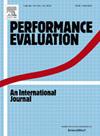马尔可夫链状态空间缩减的形式误差边界
IF 0.8
4区 计算机科学
Q4 COMPUTER SCIENCE, HARDWARE & ARCHITECTURE
引用次数: 0
摘要
我们研究了离散和连续时间马尔可夫链在缩小状态空间上的近似。在此背景下,我们扩展了近似瞬态分布的现有正式误差约束理论。在离散时间环境中,我们对误差的逐步增量进行了约束;在连续时间环境中,我们对误差的增长率进行了约束。此外,同样的误差约束也可用于约束近似静态分布离静态的距离。作为特例,我们考虑了聚集(或拼凑)马尔可夫链,通过将状态空间划分为宏状态来实现状态空间的缩小。随后,我们将误差边界与文献中的相关概念进行比较,如精确可凑合性和普通可凑合性,以及可放缩性和可聚合性。这些概念为聚集误差为零的设置提供了比必要条件更严格的条件。我们还提出了一些可能的算法,用于寻找形式误差边界较低的合适集合,并分析了这些算法在一系列不同模型上的首次实验。本文章由计算机程序翻译,如有差异,请以英文原文为准。
Formal error bounds for the state space reduction of Markov chains
We study the approximation of a Markov chain on a reduced state space, for both discrete- and continuous-time Markov chains. In this context, we extend the existing theory of formal error bounds for the approximated transient distributions. In the discrete-time setting, we bound the stepwise increment of the error, and in the continuous-time setting, we bound the rate at which the error grows. In addition, the same error bounds can also be applied to bound how far an approximated stationary distribution is from stationarity. As a special case, we consider aggregated (or lumped) Markov chains, where the state space reduction is achieved by partitioning the state space into macro states. Subsequently, we compare the error bounds with relevant concepts from the literature, such as exact and ordinary lumpability, as well as deflatability and aggregatability. These concepts provide stricter than necessary conditions for settings in which the aggregation error is zero. We also present possible algorithms for finding suitable aggregations for which the formal error bounds are low, and we analyze first experiments with these algorithms on a range of different models.
求助全文
通过发布文献求助,成功后即可免费获取论文全文。
去求助
来源期刊

Performance Evaluation
工程技术-计算机:理论方法
CiteScore
3.10
自引率
0.00%
发文量
20
审稿时长
24 days
期刊介绍:
Performance Evaluation functions as a leading journal in the area of modeling, measurement, and evaluation of performance aspects of computing and communication systems. As such, it aims to present a balanced and complete view of the entire Performance Evaluation profession. Hence, the journal is interested in papers that focus on one or more of the following dimensions:
-Define new performance evaluation tools, including measurement and monitoring tools as well as modeling and analytic techniques
-Provide new insights into the performance of computing and communication systems
-Introduce new application areas where performance evaluation tools can play an important role and creative new uses for performance evaluation tools.
More specifically, common application areas of interest include the performance of:
-Resource allocation and control methods and algorithms (e.g. routing and flow control in networks, bandwidth allocation, processor scheduling, memory management)
-System architecture, design and implementation
-Cognitive radio
-VANETs
-Social networks and media
-Energy efficient ICT
-Energy harvesting
-Data centers
-Data centric networks
-System reliability
-System tuning and capacity planning
-Wireless and sensor networks
-Autonomic and self-organizing systems
-Embedded systems
-Network science
 求助内容:
求助内容: 应助结果提醒方式:
应助结果提醒方式:


